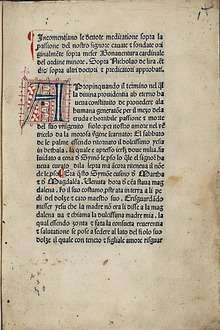Meditationes Vitae Christi
- For the book by Ludolph of Saxony see Vita Christi

The Meditationes Vitae Christi, also known as the Meditationes de Vita Christi (Meditations on the Life of Christ, later translated into Middle English as The Mirror of the Blessed Life of Jesus Christ) is a popular and important fourteenth century religious text.
During the Middle Ages, until the late nineteenth century, it was traditionally ascribed to Bonaventure. Once it was realised that the work was not by him, but by an unknown author, the ascription was changed to pseudo-Bonaventure, representing a work previously thought to have been written by Bonaventure, but now of unknown author.
Its precise date of composition, and its author, remains unknown, but has occasioned much recent debate. Stallings-Taney (1997) ascribes the work to Johannes de Caulibus. Sarah McNamer (2009) has recently disagreed. She agrees that de Caulibus may well have produced the Latin text and two-thirds of its material. She argues, however, that the core of the Meditationes in fact originated in early fourteenth century Italy and was written by an Italian nun – a core which now survives in a single Italian manuscript.[1] Michelle Karnes (2010), though, is critical of McNamer’s argument, and prefers the traditional view that the author was probably a Franciscan, given that the work is addressed to a Poor Clare.[2]
It was clearly popular in the Middle Ages, as evidenced by the survival of over two hundred manuscript copies, including seventeen illuminated ones.[3] The popularity of the work increased further with early printed editions. A Venetian edition of 1497 is the only known Italian blockbook.[4]
The work's detailed evocations of moments from the Gospels influenced art, and it has been shown to be the source of aspects of the iconography of the fresco cycle of the Life of Christ in the Scrovegni Chapel by Giotto. It has also been credited with inspiring the great increase in depictions of the Veil of Veronica from the late 14th century.
References
- ↑ Sarah McNamer, Affective Meditation and the Invention of Medieval Compassion, (Philadelphia, 2009)
- ↑ In terms of dating, the traditional acceptance of a date of composition of the early fourteenth century has been because a manuscript containing an excerpt of the work is widely agreed to be written in handwriting typical of the early fourteenth century. Sarah McNamer rejects this evidence, however, and argues that it is a later Italian manuscript, written between 1336 and 1364, which is the original core of the work. See Sarah McNamer, ‘Further evidence for the date of the pseudo-Bonaventuran Meditationes de Vita Christi’, Franciscan Studies 50, (1990), pp. 235–261, and Michelle Karnes, Imagination, meditation, and cognition in the Middle Ages, (Chicago: University of Chicago Press, 2011), p. 145.
- ↑ JSTOR, 1st page
- ↑ Metropolitan Museum
Further reading
Modern editions
- Meditationes Vitae Christi, ed by Mary Stallings-Taney, CCCM 153, (Turnhout: Brepols, 1997)
- Meditations on the Life of Christ, trans Francis X Taney, Anne Miller and C Mary Stallings-Taney, (Asheville, NC: Pegasus Press, 2000)
Secondary sources
- Michelle Karnes, Imagination, meditation, and cognition in the Middle Ages, (Chicago: University of Chicago Press, 2011)
- Emile Mâle, Religious Art in France: The Late Middle Ages, trans Marthiel Matthews, (Princeton, NJ, 1986), pp. 26–48 [A classical study of the relationship between the text and medieval art and drama]
- Sarah McNamer, ‘Further evidence for the date of the pseudo-Bonaventuran Meditationes de Vita Christi’, Franciscan Studies 50, (1990), pp. 235–261
- Sarah McNamer, 'The Origins of the Meditationes Vitae Christi ', Speculum 84 (2009), pp. 905–955
- Sarah McNamer, Affective Meditation and the Invention of Medieval Compassion, (Philadelphia, 2009)